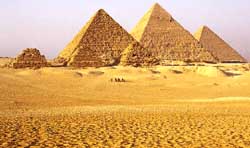DK History: Ancient Egypt
From around 3100 BC to 30 BC, the dry desert land of Egypt was home to an advanced civilization. The Ancient Egyptians produced massive PYRAMIDS, fabulous golden treasures, and wonderful works of art. They invented hieroglyphs, and were expert engineers.
The Nile River flows through Egypt on its way to the sea. Every year, between June and October, it flooded the surrounding desert and covered the land with fertile silt (fine mud). Ancient Egyptian farmers were able to grow excellent crops on this land, including wheat, barley, grapes, figs, and many different types of vegetables.
The Egyptians worshiped hundreds of gods and goddesses. Gods like Osiris, ruler of the underworld, looked human. Others were shown as animals, such as the cat-goddess Bastet, who brought fertility. The most important was ram-headed Amun, king of the gods.
Egypt became wealthy through farming and trade. Its power was built up by strong governments, led by PHARAOHS and staffed by well-trained scribes (officials). The nation was defended by huge armies.
Table 42. EGYPT’S HISTORY
| 5500–3100 BC | Pre-Dynastic Period: before the time of the Pharaohs |
| 3100 –2686 BC | Early Dynastic Period: Upper and Lower Egypt are united—Menes becomes first pharaoh |
| 2686–2181 BC | Old Kingdom: age of the pyramids |
| 2181–2055 BC | First Intermediate Period: breakdown of centralized government |
| 2055–1650 BC | Middle Kingdom: Egypt reunited |
| 1650–1550 BC | Second Intermediate Period: invasion of Hyksos people, who are then defeated |
| 1550–1069 BC | New Kingdom: Egypt at its greatest |
| 1069–747 BC | Third Intermediate Period: breaks into small states |
| 747–332 BC | Later Period: invaded by Assyrians, then Persians |
| 332–30 BC | Ptolemaic Period: conquered by Alexander the Great and ruled by his general’s family |
| 30 BC–AD 395 | Roman Period: Egypt part of Roman Empire |
Ancient Egypt was ruled by powerful kings called pharaohs, who took the roles of chief priest, war leader, and head of government. Egyptians believed that the pharaohs were living links between people and gods, and that they actually became gods after death.
Massive stone tombs protected the bodies of dead pharaohs. These pyramids represented stairways leading to the sky. They took great skill to plan and build, and were designed to keep out robbers—but no pharaoh’s MUMMY has ever been found inside one.
The pyramids were constructed by teams of skilled professional builders, such as stone masons, who were paid very well for their work. During the flood season, when the Nile River washed over the farmlands, royal officials commanded peasant farmers to assist the professional workers in building the pyramids.
A mummy is a dead body that has been carefully preserved, or mummified. Workers removed organs that might rot, then dried the body with natron (salty crystals) and wrapped it in resin-soaked bandages.
Ancient Egyptians thought that people were made up of five elements. These elements were the body, its ka (spirit), ba (personality), name, and shadow. By preserving the body, the Egyptians believed that they could keep the other four elements alive. If the body decayed, to them the person would stay dead forever.

